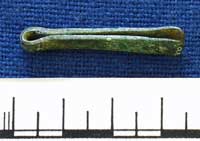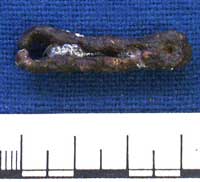 |
These tweezers (AN1929.111) are made of bronze and are attached to a wire ring. This ring was probably used to wear them by suspending them from a necklace. |
The tweezers were found in the grave of an elderly Anglo-Saxon woman at Frilford in Oxfordshire by Prof. George Rolleston in 1870. The grave also contained a knife and some fragments of iron. This lady appears not to have been particularly wealthy or prominent. |
|
Tweezers have been found in the graves of Anglo-Saxon men and women. They were various sizes. The above tweezers are about 7cm long whereas these tweezers (AN1966.3) are only 3cm long. Do you think there was a reason for this? |
 |
 |
Tweezers were made of various materials. The above ones are made of bronze, but they could also be made of iron, like the pair in the picture opposite. |
|
